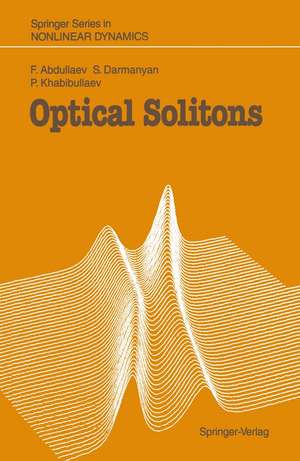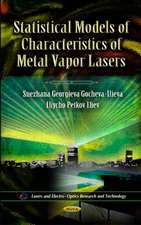Optical Solitons: Springer Series in Nonlinear Dynamics
Autor Fatkhulla Abdullaev J. Engelbrecht Autor Sergei Darmanyan, Pulat Khabibullaeven Limba Engleză Paperback – 17 apr 2014
Preț: 382.75 lei
Nou
Puncte Express: 574
Preț estimativ în valută:
73.25€ • 76.19$ • 60.47£
73.25€ • 76.19$ • 60.47£
Carte tipărită la comandă
Livrare economică 14-28 aprilie
Preluare comenzi: 021 569.72.76
Specificații
ISBN-13: 9783642877186
ISBN-10: 3642877184
Pagini: 204
Ilustrații: VIII, 192 p. 1 illus.
Dimensiuni: 155 x 235 x 17 mm
Greutate: 0.29 kg
Ediția:1993
Editura: Springer Berlin, Heidelberg
Colecția Springer
Seria Springer Series in Nonlinear Dynamics
Locul publicării:Berlin, Heidelberg, Germany
ISBN-10: 3642877184
Pagini: 204
Ilustrații: VIII, 192 p. 1 illus.
Dimensiuni: 155 x 235 x 17 mm
Greutate: 0.29 kg
Ediția:1993
Editura: Springer Berlin, Heidelberg
Colecția Springer
Seria Springer Series in Nonlinear Dynamics
Locul publicării:Berlin, Heidelberg, Germany
Public țintă
ResearchCuprins
1. Introduction.- 2. Short Pulses in Optical Fibres.- 2.1 Solitons in Single-Mode Fibres.- 2.2 Self-Phase Modulation of Pulses.- 2.3 Soliton Regime of Ultrashort Pulse Propagation. Bright and Dark Solitons.- 2.4 Observations of Solitons.- 2.5 Electromagnetic Shock Waves.- 2.6 Influence of Higher Order Dispersion and Dissipation on Soliton Dynamics.- 2.7 Amplification of Optical Solitons in Fibres.- 2.8 Modulation Instability of Electromagnetic Waves.- 2.9 Generation of Periodic Pulse Sequences.- 2.10 Multi-Mode Effects on Soliton Regimes of Propagation.- 2.11 The Soliton Laser.- 2.12 The Soliton Self-Frequency Shift.- 2.13 Multi-Component (Vector) Optical Solitons.- 3. Soliton Interaction.- 3.1 General Representations in Integrable and Nonintegrable Systems: Direct and IST-Based Methods.- 3.2 Interaction Between Optical Solitons.- 3.3 Inelastic Soliton Interactions.- 3.4 Interaction Between a Soliton and a Nonlinear Periodic Wave in an Optical Fibre.- 3.5 Solitons in Two Tunnel-Coupled Optical Waveguides.- 4. Statistical Dynamics of Optical Solitons.- 4.1 Random Pulses in an Optical Fibre. Numerical Simulation in the Presoliton Region.- 4.2 Noise Signals in the Near Field.- 4.3 Noise Signals in the Far Field.- 4.4 Random Pulses in Fibres (Soliton Region).- 4.5 Solitons in Random Nonuniform Fibres.- 4.6 Random Amplification of Solitons.- 4.7 Dynamic Chaos of Optical Solitons.- 4.8 Optical Turbulence in Passive Optical Resonators.- 5. Optical Solitons in Resonant and Active Media.- 5.1 The Maxwell-Bloch System. Soliton Solutions.- 5.2 Optical Solitons in an Active Fibre.- 5.3 Scattering of a Weak Wave on an Optical Soliton.- 5.4 Theory of Superfluorescence.- 5.5 Solitons in Stimulated Raman Scattering.- 5.6 The Evolution of SRS Solitons Under the Action of Molecular Relaxation.- 6. Quantum Optical Solitons.- 6.1 Hamiltonian Formulation of the IST-Method and Classical r-Matrix.- 6.2 Quantum Nonlinear Schrödinger Equation (QNLSE).- 6.3 Quantum Sine-Gordon System.- 6.4 The Dicke Model.- 7. Conclusion.- References.

























